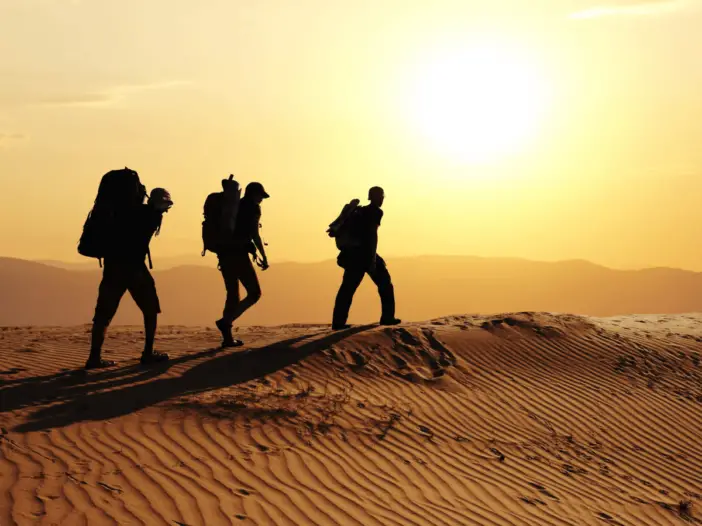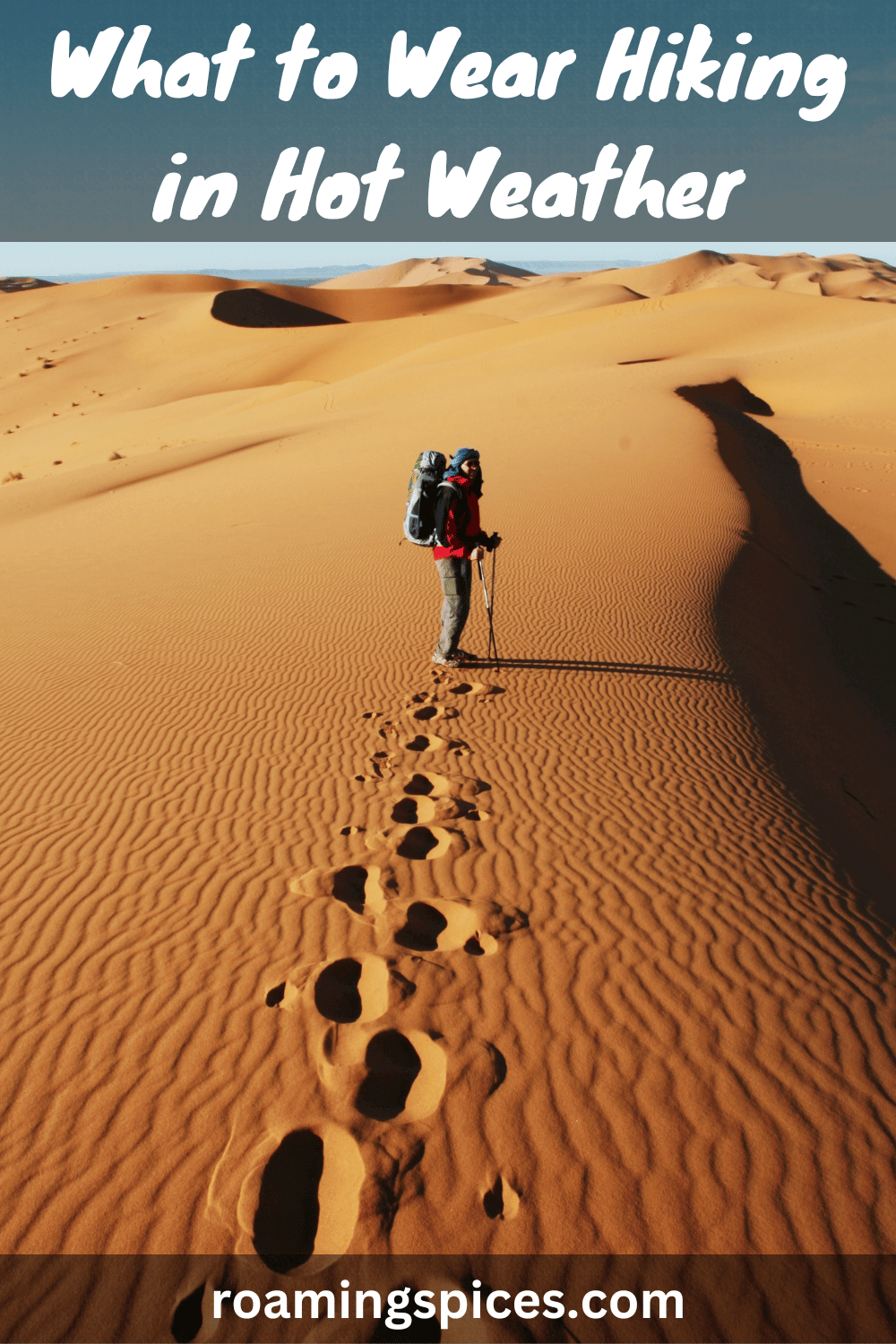
Hiking Tips
Knowing what to wear hiking in hot weather can be the difference between an enjoyable adventure and a miserable and potentially dangerous day out. Follow these tips to ensure your hot weather hike is one to remember for the right reasons
What to Wear Hiking on a Hot Day
Do you love hiking but dread doing it in hot weather? Understandably, the heat and humidity can make staying comfortable and safe on a hike difficult.
But fear not, because, in this article, we’ve covered you with some tips on what to wear hiking in hot weather.
From choosing a suitable fabric and dressing in layers to protecting yourself from the sun and staying hydrated, we’ll give you everything you need to know to make the most of your hot-weather hiking experience. So grab your water bottle, and let’s get started!
Protect Yourself from the Sun
With the high temperatures and bright sun of hot weather hiking, it’s essential to protect yourself from harmful UV rays. Sunburn, heat exhaustion, and dehydration are all potential risks when spending extended periods under the sun.
To minimize your chances of experiencing any of these, wear sunscreen with an SPF of 30 or higher and reapply it every two hours. Additionally, consider wearing a hat or visor to shade your face and sunglasses to protect your eyes from the glare.
It’s also important to wear clothing that provides adequate coverage. Lightweight, breathable fabrics like nylon and polyester are best for hot weather hiking. Long-sleeved shirts and trousers can offer extra coverage and protection from the sun’s harmful rays.
By taking the necessary precautions to protect yourself from the sun, you’ll be able to enjoy your hike without worrying about the harmful effects of extended sun exposure.
Choose the Right Fabric
Choosing the suitable fabric is crucial to staying cool and comfortable hiking in hot weather. Avoid fabrics like cotton that can trap moisture and make you feel sweaty and sticky. Instead, opt for breathable and moisture-wicking fabrics like polyester or nylon.
These materials are designed to remove moisture from your skin, keeping you dry and chafe-free. Additionally, look for fabrics that offer UPF (ultraviolet protection factor) to protect against sun damage and reduce your risk of skin cancer.
You can hike in hot weather with the right fabric without feeling weighed down or uncomfortable.
Here is a selection of good fabrics to wear hiking in hot weather:
Nylon: Nylon is a synthetic fabric that is lightweight, quick-drying, and moisture-wicking. It has excellent breathability, allowing sweat to evaporate quickly, and protects against the sun’s harmful UV rays.
Polyester: Polyester is another synthetic fabric commonly used in outdoor clothing. It is lightweight, moisture-wicking, and quick-drying, making it suitable for hot-weather hiking. Polyester fabrics often have built-in UV protection as well.
Merino Wool: Merino wool is a natural fibre known for its excellent moisture-wicking properties. It can regulate body temperature effectively, keeping you cool in hot and warm weather. Merino wool is also odour-resistant and provides some UV protection.
Bamboo: Bamboo fabric is made from the fibres of the bamboo plant. It is lightweight, breathable, and has natural moisture-wicking properties. Bamboo fabric is also hypoallergenic and provides UV protection.
Linen: Linen is a natural fabric made from the flax plant. It is lightweight, breathable, and has good moisture-wicking properties. Linen allows air to circulate, keeping you cool in hot weather. However, it may wrinkle easily.
Choose Clothes That Maximise Ventilation
When choosing clothes for hot weather hiking, it’s important to prioritise ventilation to keep yourself cool and comfortable. Here are some tips to help you maximize ventilation with your clothing choices:
Choose loose-fitting clothing: Select loose-fitting shirts, trousers, and shorts to allow air to circulate freely around your body. Avoid tight or restrictive clothing that can trap heat.
Look for mesh panels or ventilation features: Many hiking shirts and trousers have mesh panels or built-in ventilation features like zippered vents enhancing airflow and helping cool you down.
Wear lighter colours: Light-colored clothing reflects sunlight, whereas darker colours absorb heat. Therefore, light-coloured clothing options are a winner when hot weather hiking.
Don’t forget a hat and sunglasses: Protect your face and eyes from the sun by wearing a lightweight hat that provides shade and a pair of sunglasses with UV protection.
Proper footwear and socks: Choose breathable hiking shoes or boots that allow air circulation and prevent excessive sweating. Wear moisture-wicking socks to keep your feet dry and comfortable.
Dress in Layers
While adding more layers when hiking in hot weather may seem counterintuitive, dressing in layers can help regulate your body temperature and keep you comfortable on the trail.
Wearing a lightweight, long-sleeved shirt over a moisture-wicking t-shirt can provide added sun protection and prevent your skin from getting burnt.
Additionally, carrying a lightweight, packable jacket or vest can help keep you warm in the early morning or evening when temperatures drop.
By dressing in layers, you can easily adjust your clothing to your comfort level as the weather changes throughout your hike. Plus, layering allows you to remove or add clothing without stopping and completely changing your outfit.
Remember to pack your layers in a backpack or waist pack so you can access them easily when needed.
Wear UPF-rated clothing
Wearing UPF-rated clothing for hot weather hiking is beneficial for several reasons:
Sun Protection: UPF (Ultraviolet Protection Factor) is a rating system used to measure the effectiveness of fabrics in blocking harmful UV rays from the sun. UPF-rated clothing provides an extra layer of protection against UVA and UVB rays.
Prolonged exposure to the sun can lead to sunburn, skin damage, and an increased risk of skin cancer. UPF-rated clothing helps to minimize this risk by blocking a significant amount of UV radiation.
Convenience: While sunscreen is essential, it needs to be reapplied regularly, especially when sweating or swimming. UPF-rated clothing offers continuous protection without the need for frequent reapplication.
It is a reliable and convenient form of sun protection, allowing you to focus more on your hike and less on reapplying sunscreen.
Cooling Effect: UPF-rated clothing is often designed with moisture-wicking and quick-drying properties, which can help keep you cool and comfortable during hot weather hiking.
These fabrics efficiently pull sweat away from your skin, allowing it to evaporate faster and keeping you dry. This helps to regulate body temperature and prevent overheating.
Durability: UPF-rated clothing is specifically manufactured to provide sun protection. The fabrics are designed to maintain their UPF rating even after prolonged exposure to sunlight and multiple washes. This durability ensures that the clothing retains its protective qualities for an extended period.
When selecting UPF-rated clothing, look for garments with higher UPF ratings, ideally UPF 50+, which provides excellent protection.
Stay Hydrated
By caring for your skin, you’ve already taken the first step towards a successful hike in hot weather. However, staying hydrated is just as important.
As you sweat, your body loses water and essential minerals, which can lead to dehydration. Symptoms of dehydration include dizziness, fatigue, and decreased urine output. In extreme cases, dehydration can even be life-threatening.
To prevent dehydration, drink plenty of water before you start your hike. A good rule of thumb is to drink at least half a litre of water about an hour before you hit the trail.
During your hike, carry plenty of water with you and sip on it regularly. If you’re hiking for more than an hour or two, you may consider bringing a water purification system or tablets to refill your water bottle from natural sources.
In addition to water, consider bringing an electrolyte drink or snack to help replace the sodium, potassium, and other minerals lost through sweat. A sports drink or electrolyte gel can provide the necessary nutrients to keep your muscles working and your mind sharp during your hike.
By staying hydrated, you’ll be able to maintain your energy levels and stay safe during your hot weather hike. And with the right clothing, you’ll fully enjoy the beauty of your surroundings without worrying about the sun’s harmful effects.
What to Wear Hiking in Hot Weather – Conclusion
Dressing appropriately for hiking in hot weather is essential for both comfort and safety on the trail. By considering key factors such as fabric choice, breathability, sun protection, and moisture management, you can ensure an enjoyable and safe hiking experience even in scorching temperatures.
So, gear up, choose the proper attire, and embark on unforgettable hiking journeys even in the hottest conditions.
With these essentials in mind, you can enjoy the great outdoors without suffering the heat. As you step out into the wilderness, remember the words of naturalist John Muir:
“In every walk with nature, one receives far more than he seeks.” So take care and enjoy every step of your adventure!
Like Our Article? Please Pin it!


Leave a Reply